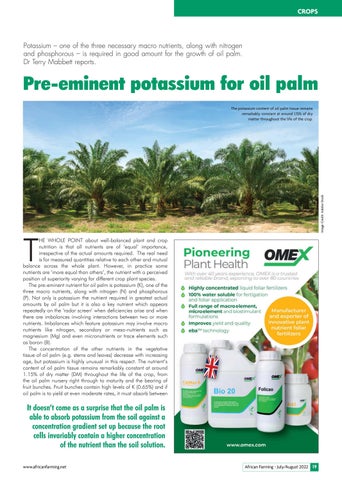S05 AF July_August 2022 Beef production_Layout 1 25/07/2022 11:14 Page 19
CROPS
Potassium – one of the three necessary macro nutrients, along with nitrogen and phosphorous – is required in good amount for the growth of oil palm. Dr Terry Mabbett reports.
Pre-eminent potassium for oil palm
Image Credit: Adobe Stock
The potassium content of oil palm tissue remains remarkably constant at around 1.15% of dry matter throughout the life of the crop.
T
HE WHOLE POINT about well-balanced plant and crop nutrition is that all nutrients are of ‘equal’ importance, irrespective of the actual amounts required. The real need is for measured quantities relative to each other and mutual balance across the whole plant. However, in practice some nutrients are ‘more equal than others’, the nutrient with a perceived position of superiority varying for different crop plant species. The pre-eminent nutrient for oil palm is potassium (K), one of the three macro nutrients, along with nitrogen (N) and phosphorous (P). Not only is potassium the nutrient required in greatest actual amounts by oil palm but it is also a key nutrient which appears repeatedly on the ‘radar screen’ when deficiencies arise and when there are imbalances involving interactions between two or more nutrients. Imbalances which feature potassium may involve macro nutrients like nitrogen, secondary or meso-nutrients such as magnesium (Mg) and even micronutrients or trace elements such as boron (B). The concentration of the other nutrients in the vegetative tissue of oil palm (e.g. stems and leaves) decrease with increasing age, but potassium is highly unusual in this respect. The nutrient’s content of oil palm tissue remains remarkably constant at around 1.15% of dry matter (DM) throughout the life of the crop, from the oil palm nursery right through to maturity and the bearing of fruit bunches. Fruit bunches contain high levels of K (0.65%) and if oil palm is to yield at even moderate rates, it must absorb between
It doesn’t come as a surprise that the oil palm is able to absorb potassium from the soil against a concentration gradient set up because the root cells invariably contain a higher concentration of the nutrient than the soil solution. www.africanfarming.net
African Farming - July/August 2022 19







